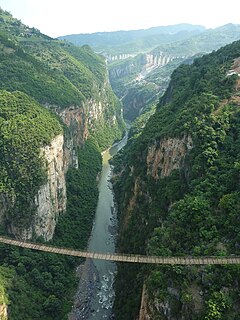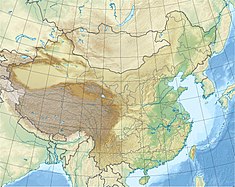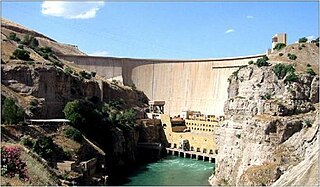
The Dukan Dam is a multi-purpose concrete arch dam in As Sulaymaniyah Governorate, Kurdistan Region of Iraq. It impounds the Little Zab, thereby creating Lake Dukan. The Dukan Dam was built between 1954 and 1959 whereas its power station became fully operational in 1979. The dam is 360 metres (1,180 ft) long and 116.5 metres (382 ft) high and its hydroelectric power station has a maximum capacity of 400 MW.

Toonumbar Dam is a minor ungated rock fill with clay core embankment dam with a concrete chute spillway across the Iron Pot Creek north-west of Casino in the Northern Rivers region of New South Wales, Australia. The dam's purpose includes hydro-power, irrigation, water supply, and conservation. The impounded reservoir is called Lake Toonumbar.

The Badush Dam is an unfinished multi-purpose dam on the Tigris River, located near Badush, 16 kilometres (9.9 mi) northwest of Mosul in the Ninawa Governorate, northern Iraq.
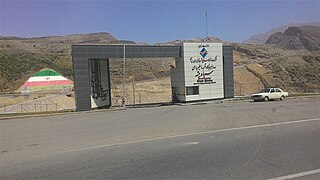
The Siah Bisheh Pumped Storage Power Plant, also spelled Siyāhbisheh and Siah Bishe, is located in the Alborz Mountain range near the village of Siah Bisheh and 48 km (30 mi) south of Chalus in Mazandaran Province, Iran. The power plant uses the pumped-storage hydroelectric method to generate electricity during periods of high energy demand, making it a peaking power plant, intended to fulfill peak electricity demand in Tehran 60 km (37 mi) to the south. When complete it will have an installed generating capacity of 1,040 megawatts (1,390,000 hp) and a pumping capacity of 940 megawatts (1,260,000 hp). Planning for the project began in the 1970s and construction began in 1985. It was delayed from 1992 until 2001 and the first generator went online in May 2013. The remaining generators were commissioned by 1 September 2015. The power plant is the first pumped-storage type in Iran and will also use the country's first concrete-face rock-fill dam – two of them.

The Salto Santiago Hydroelectric Power Plant is a dam and hydroelectric power plant on the Iguazu River near Santiago in Paraná, Brazil. It is the third dam upstream of the Iguazu Falls and was completed in 1979. The power station has a 1,420 MW capacity and is supplied with water by a rock-fill embankment dam.

The Governor Bento Munhoz da Rocha Netto Hydroelectric Plant, formerly known as Foz do Areia, is dam and hydroelectric power plant on the Iguazu River near Foz do Areia in Paraná, Brazil. It is the furthest dam upstream of the Iguazu Falls and was constructed between 1976 and 1980. The power station has a 1,676 megawatts (2,248,000 hp) capacity and is supplied with water by a concrete face rock-fill embankment dam.

The Itumbiara Dam is an embankment dam on the Paranaíba River near Itumbiara in Goiás, Brazil. The dam serves an associated hydroelectric power plant with a 2,082 megawatts (2,792,000 hp) installed capacity. The power plant is the sixth largest in Brazil and has the largest installed capacity of Eletrobrás Furnas' power plants.

The Serra da Mesa Dam, once known as Sao Felix, is an embankment dam on the Tocantins River near Minaçu in Goiás, Brazil. The dam serves an associated hydroelectric power plant with a 1,275 megawatts (1,710,000 hp) installed capacity. The dam creates the largest reservoir by volume in Brazil.

The Marimbondo Dam is an embankment dam on the Grande River near Fronteira in Minas Gerais, Brazil. The dam serves an associated hydroelectric power plant with a 1,440 megawatts (1,930,000 hp) installed capacity.

The Engineer Souza Dias Dam, formerly known as the Jupiá Dam is an embankment dam on the Paraná River near Três Lagoas in Mato Grosso do Sul, Brazil. It was constructed for hydroelectric power production, flood control and navigation. Studies on the dam and power plant began in 1951 which recommended the dam along with the Ilha Solteira Dam. The dam was inaugurated in 1968 and its generators were commissioned between 1969 and 1974.

The Água Vermelha Dam is an embankment dam on the Grande River near Iturama in Minas Gerais/São Paulo, Brazil. It was constructed for hydroelectric power production and flood control. Construction on the dam began in 1973 and it was completed and operational by 1978. The last generators were operational in 1979.

The Tianhuangping Pumped Storage Power Station is a pumped-storage power station in Tianhuangping, Anji County of Zhejiang Province, China. The power station has an installed capacity of 1,836 megawatts (2,462,000 hp) utilizing 6 reversible Francis turbines. Construction began in 1993 and the power station was completed in 2004.

The Liuxihe Dam is an arch dam on the Liuxihe River near Conghua, in Guangdong Province, China. The main purpose of the project is hydroelectric power generation with additional purposes of flood control and irrigation. The dam is 78 metres (256 ft) tall and was constructed between 1956 and 1958.

The Baishan Dam is an arch-gravity dam on the Second Songhua River near the town of Baishanzhen, Huadian, Jilin Province, China. The purpose of the dam is hydroelectric power generation and flood control. The dam supplies water to five turbine-generators in two different powerhouses for an installed capacity of 1,500 megawatts (2,000,000 hp) while it can also control a design 19,100 cubic metres per second (670,000 cu ft/s) flood. Additionally, it has a 300 megawatts (400,000 hp) pumped-storage hydroelectric generation capacity. It is named after Baekdu Mountain, near the city of Baishan.

The Chirkey Dam is an arch dam on the Sulak River in Dagestan, Russia. The main purpose of the dam is hydroelectric power production and it supports a 1,000 MW power station. Construction on the dam began in 1964, the first generator was operational by 1974, the last in 1976 while the project was officially completed in 1978. It is the tallest arch dam in Russia.

The Aras Dam is an embankment dam on the Aras River along the border of Iran and Azerbaijan. It is located downstream of Poldasht in West Azerbaijan Province, Iran and Nakhchivan City in Nakhchivan Autonomous Republic, Azerbaijan. The primary purpose of the dam is hydroelectric power production and water supply.

The Miel I Dam, officially known as the Patángoras Dam, is a gravity dam on La Miel River just south of Norcasia in Caldas Department, Colombia. The dam was constructed between 1997 and 2002 for the primary purpose of hydroelectric power generation. At the time of its completion, the dam was the tallest roller-compacted concrete (RCC) dam in the world but was surpassed by the Longtan Dam in 2009.

The Porce III Dam is an embankment dam on the Porce River 90 kilometres (56 mi) northeast of Medellín in Antioquia Department, Colombia. The dam was constructed between 2004 and 2011 for the primary purpose of hydroelectric power generation.
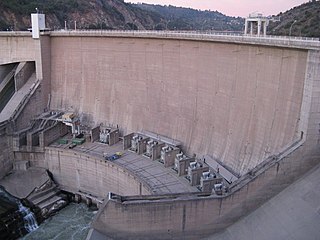
The Rapel Dam is an arch dam on the Rapel River about 19 km (12 mi) north of La Estrella in the Libertador General Bernardo O'Higgins Region, Chile. The primary purpose of the dam is hydroelectric power generation and it supports a 377 MW power station. The dam was completed in 1968 and is owned by Endesa. It creates the largest reservoir in Chile with a capacity of 700,000,000 m3 (567,499 acre⋅ft). The dam withstood the 7.5 Mw 1985 Rapel Lake earthquake with only minor damage. It was centered 45 km (28 mi) from the dam.

The Guxian Dam is a concrete gravity dam on the Luo River, a tributary of the Yellow River, in Luoning County, Henan Province, China. The primary purpose of the dam is flood control but it also generates hydroelectricity and provides water for irrigation. The 125 m (410 ft) tall dam withholds a reservoir of 1,175,000,000 m3 (952,588 acre⋅ft) and provides 848,000,000 m3 (687,485 acre⋅ft) in flood storage. The dam's power station contains three 20 MW Francis turbine-generators for a total installed capacity of 60 MW. Construction on the dam began in 1958 but was suspended several times afterwards. It recommenced in 1978 and the reservoir began to fill in 1991. The dam's generators were commissioned in 1992 and the project complete in 1993. The dam's spillway is controlled by five tainter gates and has a maximum discharge capacity of 11,436 m3/s (403,859 cu ft/s). Flip buckets are used at the spillway base to dissipate water. On the right side of the spillway there are two intermediate orifice openings controlled by hydraulic press-operated radial gates. Two bottom outlets are set on the spillway's left side, also controlled by hydraulic press-operated radial gates. To the left of the bottom outlets is the power station.

